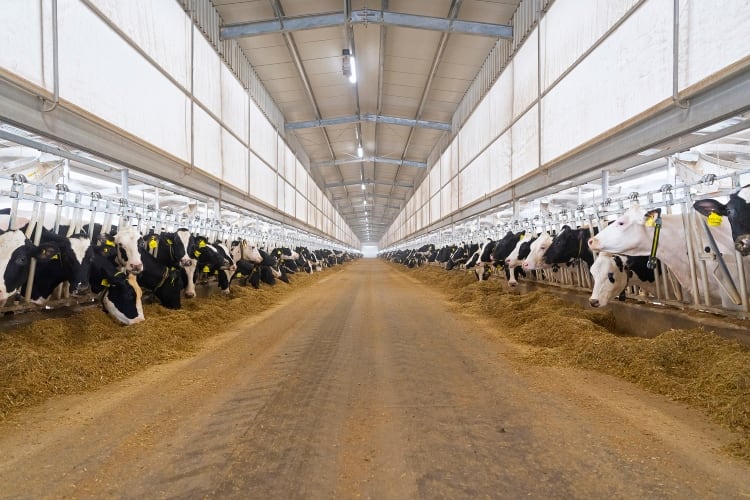Despite enormous advances in agricultural technologies over recent decades, global farming systems remain inefficient, based upon dysfunctional supply chains that are unsuited to meet rising demand. Nowhere is this truer than in the dairy sector.
Inefficiencies and risk
Global dairy production is rife with inefficiencies and unreliable supply, exacerbated by the constrictions of pandemic economics. Reduced sales volumes have applied pressure on margins, forcing farmers to further contain costs, while the inability to distribute food globally during this time has demonstrated the importance of producing locally. What’s more, a heavy reliance on manual labor has negatively affected farms whose workforces have faced restrictions on mobility and the positive environmental benefits from lower travel and consumption during the pandemic will only increase a desire for fresher produce locally produced and sustainability.
Take the example of Ukraine: despite its status as Europe’s second largest country, Ukraine’s dairy supply chains deliver less than optimal outcomes. Dairy farming in Ukraine is structured predominantly around small-scale dairy farms that produce more than two-thirds of the country’s total milk production - producing small volumes of milk, which they sell to processors for less than $0.40 per liter. There is a constant shortfall of supply and low margins, which leads to a chronic lack of investment in infrastructure, exacerbating the problems further. Consequently, despite being 97% self-sufficient in milk, of the 9.7bn total liters produced, only 3.7bn liters are processed.
Integration is the key
Large-scale integrated dairy farming provides the solution to inefficiency and supply chain risk. Its goal is to produce the highest quality milk at the lowest cost per liter, using the principle of comprehensiveness and central management to generate maximum economies of scale.
This approach provides ‘grass-to-glass’ productivity, security and provenance in the manufacture and delivery of dairy produce. The farm produces the grass, which feeds the cows. The farm in turn produces, processes, and distributes the milk, thereby controlling the entire supply chain and ensuring efficient, profitable and sustainable production.
Efficient planning is vital. Locating a forage farm as close to the dairy farm as possible reduces logistic costs and boosts margins - for a herd of 10,000 milking cows the land requirement would be approximately 4,000 hectares.
Technology and scale
Technological innovation is a key characteristic of integrated farming, with large-scale farming typically centred around standardization, mechanization and the ongoing genetic improvement of the dairy herd. Automated processes such as the monitoring and feeding of cows help to replace manual labor, optimize efficiency and smooth production and distribution processes.
Real-time monitoring of the behavior, location, hygiene, health, eating habits and milk production of each cow through collar sensor technology also delivers enhanced productivity and speed. In turn, this improves yield, while simultaneously limiting errors and delays and reducing costs.
Through the Internet of Things, machines can be controlled proactively and remotely, 24/7. Artificial intelligence algorithms enable more predictive and advanced systems, reducing system down-time. Similarly, drones, robots, proximity sensors for vehicles, and smart PPE are all contributing to improved employee safety and less strenuous work in dairy plants.
Furthermore, the use of total mixed rations (TMR) feed for cows increases milk yields further. Keeping livestock in a carefully-controlled and fully air-conditioned environment ensures each animal is protected from high humidity levels, reducing stress levels, and providing access to better feed. This level of environmental control not only means a higher proportion of energy can go to milk production rather than cow maintenance, but also improves animal health and well-being and ultimately the quality of the milk.
Also, integrated dairy farming ensures dairy farmers not only produce milk, but can also produce electricity safely and cost effectively, by utilizing solar and wind energy technology, or by burning biogas from cow slurry. Surplus energy can subsequently be sold back to the grid, ensuring complete sustainability.
A need to act
Baladna’s commitment to integrated dairy techniques has delivered a rolling herd average of 39 liters across our Qatari operations three years after start up, compared to an average of 13 liters in Ukraine. We continue to bring our integrated methodology to new markets, with new partnerships recently put in place with the governments of Malaysia and Ukraine. In the case of Malaysia, this will install a herd of 10,000 dairy cattle that will deliver 100m liters of fresh milk in the first year of operation.
Governments globally, not least across the developing world, must do all they can to embrace integrated dairy farming. It is the future of sustainable and cost-effective dairy production.

